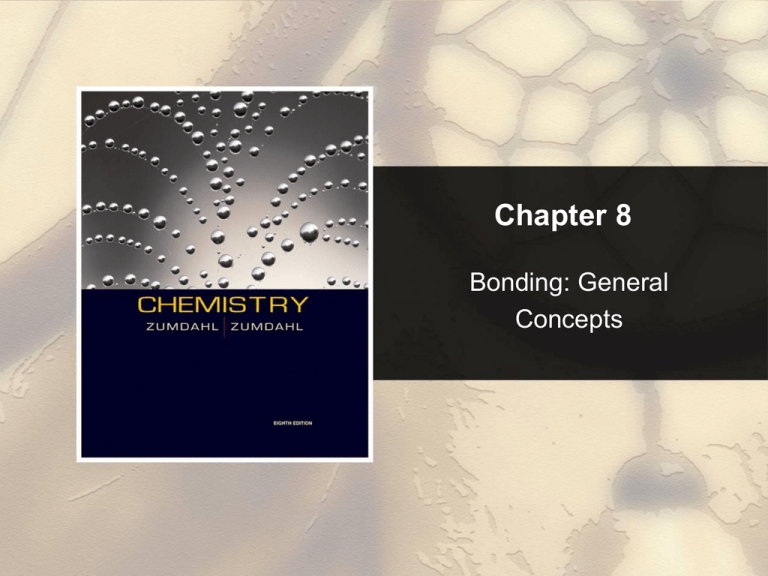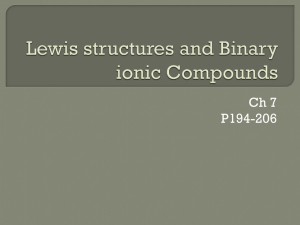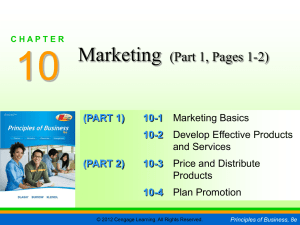
Chapter 8
Bonding: General
Concepts
Chapter 8
Table of Contents
8.1
8.2
8.3
8.4
8.5
8.6
8.7
8.8
8.9
8.10
8.11
8.12
8.13
Types of Chemical Bonds
Electronegativity
Bond Polarity and Dipole Moments
Ions: Electron Configurations and Sizes
Energy Effects in Binary Ionic Compounds
Partial Ionic Character of Covalent Bonds
The Covalent Chemical Bond: A Model
Covalent Bond Energies and Chemical Reactions
The Localized Electron Bonding Model
Lewis Structures
Exceptions to the Octet Rule
Resonance
Molecular Structure: The VSEPR Model
Chapter 8
Questions to Consider
• What is meant by the term “chemical bond”?
• Why do atoms bond with each other to form
compounds?
• How do atoms bond with each other to form
compounds?
Copyright © Cengage Learning. All rights reserved
3
Section 8.1
Types of Chemical Bonds
Objectives 8.1 – 8.3
1. To learn about ionic and covalent bonds
and explain how they are formed
2. To learn about the polar covalent bond
3. To understand the nature of bonds and
their relationship to electronegativity
4. To understand bond polarity and how it is
related to molecular polarity
Return to TOC
Copyright © Cengage Learning. All rights reserved
4
Section 8.1
Types of Chemical Bonds
A. Types of Chemical Bonds
• Bond – force that holds groups of atoms together and
makes them function as a unit
• Bond energy – energy required to break a chemical bond
Return to TOC
Copyright © Cengage Learning. All rights reserved
5
Section 8.1
Types of Chemical Bonds
A. Types of Chemical Bonds
https://www.youtube.com/watch?v=_M9khs87xQ8
https://www.youtube.com/watch?v=QqjcCvzWwww#t=35
Ionic Bonding
(a)
(b)
• Ionic compound results when a metal reacts with a
nonmetal. Results from a transfer of one or more e-s.
Return to TOC
Copyright © Cengage Learning. All rights reserved
6
Types of Bonds
20.2
Sharing Electrons
Section 8.1
Types of Chemical Bonds
A. Types of Chemical Bonds
Covalent Bonding
• A covalent bond results when electrons are shared by nuclei
• Bond, Ionic Bond…
Return to TOC
Copyright © Cengage Learning. All rights reserved
8
Section 12.1
Characteristics of Chemical Bonds
Section 8.1
Types of Chemical Bonds
A. Types of Chemical Bonds
Covalent Bonding
• A polar covalent bond results when electrons are shared
unequally by nuclei
– One atom attracts the electrons more than the other atom
Return to TOC
Copyright © Cengage Learning. All rights reserved
10
Section 8.1
Types of Chemical Bonds
B. Electronegativity
• Electronegativity – the relative ability of an atom in a
molecule to attract shared electrons to itself
– Increases from left to right across a period
– Decreases down a group of representative elements
– Why don’t noble gases have electronegativity values?
Return to TOC
Copyright © Cengage Learning. All rights reserved
11
Section 8.1
Types of Chemical Bonds
The Pauling Electronegativity Values
Return to TOC
Copyright © Cengage Learning. All rights reserved
12
Section 8.1
Types of Chemical Bonds
B. Electronegativity
• The polarity of a bond depends on the difference
between the electronegativity values of the atoms
forming the bond (partial charge, delta)
Return to TOC
Copyright © Cengage Learning. All rights reserved
13
Section 8.1
Types of Chemical Bonds
B. Electronegativity
Return to TOC
Copyright © Cengage Learning. All rights reserved
14
Section 8.1
Types of Chemical Bonds
B. Electronegativity
• The polarity of a bond depends on the difference
between the electronegativity values of the atoms
forming the bond
• If electronegativity < 0.1, covalent (nonpolar) bond
• If 0.1 < electronegativity < 1.7, Polar covalent bond
• If electronegativity > 1.7, Ionic Bond
• Look on the back of Periodic Table to find
electronegativity values.
• Classify the following Bonds:
• KF
• O2
• ICl
Show the Partial Negative
Return to TOC
Copyright © Cengage Learning. All rights reserved
15
Section 8.1
Types of Chemical Bonds
B. Electronegativity
• For each of the following pairs of bonds, choose the
bond that is more polar and assign the partial negative.
• H—P, H—C
• N—O, S—O
• O—F, O—I
• N—H, Si—H
Return to TOC
Copyright © Cengage Learning. All rights reserved
16
Section 8.1
Types of Chemical Bonds
C. Bond Polarity and Dipole Moments
• A dipole moment results when a polar molecule has a
center for positive charge separate from a center for
negative charge (partial charge, polar molecule, magnet)
• Lower Case delta. Greek letters?
Return to TOC
Copyright © Cengage Learning. All rights reserved
17
Section 8.1
Types of Chemical Bonds
The Effect of an Electric Field on Hydrogen Fluoride Molecules
or indicates a positive or negative fractional charge.
Return to TOC
Copyright © Cengage Learning. All rights reserved
18
Section 8.1
Types of Chemical Bonds
Polar Molecules
Return to TOC
Copyright © Cengage Learning. All rights reserved
19
Section 8.1
Types of Chemical Bonds
C. Greek Alphabet
Return to TOC
Copyright © Cengage Learning. All rights reserved
20
Section 8.1
Types of Chemical Bonds
C. Bond Polarity and Dipole Moments
• Water molecule dipole moment
Return to TOC
Copyright © Cengage Learning. All rights reserved
21
Section 8.3
Bond Polarity and Dipole Moments
Dipole Moment
Return to TOC
Copyright © Cengage Learning. All rights reserved
22
Section 8.3
Bond Polarity and Dipole Moments
No Net Dipole Moment (Dipoles Cancel)
Return to TOC
Copyright © Cengage Learning. All rights reserved
23
Section 8.1
Types of Chemical Bonds
C. Bond Polarity and Dipole Moments
• The polarity of water affects its properties
– Permits ionic compounds to dissolve in it
– Magnetic properties cause water molecules to stick
together and remain liquid at higher temperature
Return to TOC
Copyright © Cengage Learning. All rights reserved
24
Section 8.2
Electronegativity
Concept Check
If lithium and fluorine react, which has more
attraction for an electron? Why?
In a bond between fluorine and iodine, which
has more attraction for an electron? Why?
Return to TOC
Copyright © Cengage Learning. All rights reserved
25
Section 8.2
Electronegativity
Concept Check
What is the general trend for electronegativity
across rows and down columns on the
periodic table?
Explain the trend.
Return to TOC
Copyright © Cengage Learning. All rights reserved
26
Section 8.2
Electronegativity
Exercise
Arrange the following bonds from most to least
polar:
a) N–F
b) C–F
O–F
N–O
C–F
Si–F
a)
b)
N–F,
C–F,
O–F
N–O
C–F,
Si–F,
Return to TOC
Copyright © Cengage Learning. All rights reserved
27
Section 8.2
Electronegativity
Concept Check
Which of the following bonds would be the
most polar without being considered ionic?
Mg–O C–O O–O Si–O N–O
Return to TOC
Copyright © Cengage Learning. All rights reserved
28
Section 8.3
Bond Polarity and Dipole Moments
Objectives Review 8.1 – 8.3
1. To learn about ionic and covalent bonds
and explain how they are formed
2. To learn about the polar covalent bond
3. To understand the nature of bonds and
their relationship to electronegativity
4. To understand bond polarity and how it is
related to molecular polarity
5. Work Session: Page 382 #1, 3, 11, 23, 25
Return to TOC
Copyright © Cengage Learning. All rights reserved
29
Section 8.4
Ions: Electron Configurations and Sizes
Objectives 8.4 – 8.8
1. To learn about stable electron configurations
2. To learn to predict the formulas of ionic
compounds
3. To learn about the structures of ionic
compounds
4. To understand factors governing ionic size
Return to TOC
Copyright © Cengage Learning. All rights reserved
30
Section 8.4
Ions: Electron Configurations and Sizes
A. Stable Electron Configurations and Charges on Ions
Return to TOC
Copyright © Cengage Learning. All rights reserved
31
Section 8.4
Ions: Electron Configurations and Sizes
A. Stable Electron Configurations and Charges on Ions
Return to TOC
Copyright © Cengage Learning. All rights reserved
32
Section 8.4
Ions: Electron Configurations and Sizes
A. Stable Electron Configurations and Charges on Ions
• Atoms in stable compounds usually have a noble
gas electron configuration
– Metals lose electrons to reach noble gas
configuration
– Nonmetals gain electrons to reach noble gas
configuration
– Full valence electron orbitals are more stable
than partly full valence orbitals. Think spin and
overall balance.
Return to TOC
Copyright © Cengage Learning. All rights reserved
33
Section 8.4
Ions: Electron Configurations and Sizes
A. Stable Electron Configurations and Charges on Ions
Predicting Formulas of Ionic compounds
• Chemical compounds are always electrically neutral
• They tend to resemble noble gas electron configurations
• Isoelectronic – having the same electron configurations
Return to TOC
Copyright © Cengage Learning. All rights reserved
34
Section 8.4
Ions: Electron Configurations and Sizes
B. Ionic bonding and Structures of Ionic Compounds
Structures of Ionic Compounds
• Ions are packed together to maximize the attractions
between ions
Return to TOC
Copyright © Cengage Learning. All rights reserved
35
Section 8.4
Ions: Electron Configurations and Sizes
B. Ionic bonding and Structures of Ionic Compounds
•
•
•
•
•
Structures of Ionic Compounds
Cations are always
smaller than the parent
atom
Anions are always
larger than the parent
atom
Why?
Cations lose e-s, get
smaller
Anions gain e-s, get
bigger
Copyright © Cengage Learning. All rights reserved
Return to TOC
36
Section 8.4
Ions: Electron Configurations and Sizes
B. Ionic bonding and Structures of Ionic Compounds
Ionic Compounds Containing Polyatomic Ions
• Polyatomic ions work in the same way as simple ions
– The covalent bonds hold the polyatomic ion together so it
behaves as a unit
Return to TOC
Copyright © Cengage Learning. All rights reserved
37
Section 8.4
Ions: Electron Configurations and Sizes
Ionic Radii
Return to TOC
Copyright © Cengage Learning. All rights reserved
38
Section 8.5
Energy Effects in Binary Ionic Compounds
Born-Haber Cycle for NaCl
Return to TOC
Copyright © Cengage Learning. All rights reserved
39
Section 8.7
The Covalent Chemical Bond: A Model
Models
• Models are attempts to explain how nature
operates on the microscopic level based on
experiences in the macroscopic world.
Return to TOC
Copyright © Cengage Learning. All rights reserved
40
Section 8.7
The Covalent Chemical Bond: A Model
Fundamental Properties of Models
1. A model does not equal reality.
2. Models are oversimplifications, and are
therefore often wrong.
3. Models become more complicated and are
modified as they age.
4. We must understand the underlying
assumptions in a model so that we don’t misuse
it.
5. When a model is wrong, we often learn much
more than when it is right.
Return to TOC
Copyright © Cengage Learning. All rights reserved
41
Section 8.4
Ions: Electron Configurations and Sizes
Objectives Review 8.4 – 8.8
1. To learn about stable electron configurations
2. To learn to predict the formulas of ionic
compounds
3. To learn about the structures of ionic
compounds
4. To understand factors governing ionic size
5. Work Session: Page 383 #29, 35, 37, 41
Return to TOC
Copyright © Cengage Learning. All rights reserved
42
Section 8.9
The Localized Electron Bonding Model
Objectives 8.9 – 8.12
1. To learn to write Lewis structures
2. To learn to write Lewis structures for
molecules with multiple bonds
3. To understand how symmetry affects
molecular polarity
4. To write resonance Lewis structures
Return to TOC
Copyright © Cengage Learning. All rights reserved
43
Section 8.9
The Localized Electron Bonding Model
A. Writing Lewis Structures
• In writing Lewis structures we include only the valence
electrons (Roman Numeral Group Number)
• Most important requirement
– Atoms achieve noble gas electron configuration
(octet rule, duet rule for H)
Return to TOC
Copyright © Cengage Learning. All rights reserved
44
Section 8.9
The Localized Electron Bonding Model
A. Writing Lewis Structures
• Bonding pairs are shared between 2 atoms
• Unshared pairs (lone pairs) are not shared and not
involved in bonding
• H2, Cl2, Br2, I2
Return to TOC
Copyright © Cengage Learning. All rights reserved
45
Section 8.9
The Localized Electron Bonding Model
A. Writing Lewis Structures (page 355)
• Determine the TOTAL number of valence e-s from all atoms
• Draw a symmetrical skeleton structure- First atom (not H) is
frequently the central atom– any atom bonded to > 1 other
atom
– Bonded atom – any atom bonded to a central atom
• Bonded atoms get e-s in pairs to fill their octet/duet.
• Use the remaining e-s in pairs to satisfy the octet rule for the
central atom. Circle the octets!
• THINK SYMMETRY!
Copyright © Cengage Learning. All rights reserved
Return to TOC
46
Section 8.9
The Localized Electron Bonding Model
A. Writing Lewis Structure for H2O
Return to TOC
Copyright © Cengage Learning. All rights reserved
47
Section 8.9
The Localized Electron Bonding Model
A. Writing Lewis Structures
• HF
• NF3
• NH3
• CH4
• CF4
• CCl4
• PH3
Circle the Octet
• CH3Cl
• H2S
• SiF4
• HCl
Return to TOC
Copyright © Cengage Learning. All rights reserved
48
Section 8.9
The Localized Electron Bonding Model
A. Writing Lewis Structures
• Write the Lewis Structures for the following polyatomic ions:
•
•
•
•
•
•
•
SO4-2
NH4+
ClO4PH4+
OHPO4-3
O2-2
See the octet?
Return to TOC
Copyright © Cengage Learning. All rights reserved
49
Section 8.9
The Localized Electron Bonding Model
B. Lewis Structures of Molecules with Multiple Bonds
• Single bond – covalent bond in which 1 pair of electrons is
shared by 2 atoms
• Double bond – covalent bond in which 2 pairs of electrons
are shared by 2 atoms
• Triple bond – covalent bond in which 3 pairs of electrons are
shared by 2 atoms
• Annotated Rule For Lewis Dot Structures:
• If sharing 1 pair of e-s in a bond doesn’t fill the octet rule, try
2 pairs of e-s or 3 pairs of e-s.
Return to TOC
Copyright © Cengage Learning. All rights reserved
50
Section 8.9
The Localized Electron Bonding Model
B. Lewis Structures of Molecules with Multiple Bonds
•
•
•
•
•
•
•
•
•
•
•
Write the Multiple Bond Lewis Structures for the following:
O2
N2
CO
NO+
HCN (C is the central atom)
C2H4 (Ethene)
C2F4 (Teflon)
SO2
CNCS2
Molecular polarity and resonance
Copyright © Cengage Learning. All rights reserved
Return to TOC
51
Section 8.9
The Localized Electron Bonding Model
B. Lewis Structures of Molecules with Multiple Bonds
– A molecule shows resonance when more than one
Lewis structure can be drawn for the molecule
– 10 point Basketball Leader
Return to TOC
Copyright © Cengage Learning. All rights reserved
52
Section 8.12
Resonance
• Actual structure is an average of the resonance
structures.
• Electrons are really delocalized – they can move
around the entire molecule.
O
O
N
O
O
O
O
N
O
O
N
O
Return to TOC
Copyright © Cengage Learning. All rights reserved
53
Section 8.9
The Localized Electron Bonding Model
B. Lewis Structures of Molecules with Resonance
• Write the Resonance Lewis Structures for the following:
• NO3• SO3
• ClO3• SO2
• CO3-2
• O3
Copyright © Cengage Learning. All rights reserved
Return to TOC
54
Section 8.9
The Localized Electron Bonding Model
B. Lewis Structures of Molecules
Show the Orbital diagram, the octet, and the pairing.
– BrF
– HI
– Analyze the bonds to determine if the molecule will
exhibit a dipole moment.
Return to TOC
Copyright © Cengage Learning. All rights reserved
55
Section 8.9
The Localized Electron Bonding Model
Objectives Review 8.9 – 8.12
1. To learn to write Lewis structures
2. To learn to write Lewis structures for
molecules with multiple bonds
3. To understand how symmetry affects
molecular polarity
4. To write resonance Lewis structures
5. Work Session: Page 384 # 67, 73
Pare
Return to TOC
Copyright © Cengage Learning. All rights reserved
56
Section 8.13
Molecular Structure: The VSEPR Model
VSEPR
Return to TOC
Copyright © Cengage Learning. All rights reserved
57
Section 8.13
Molecular Structure: The VSEPR Model
VSEPR: Two Electron Pairs
Return to TOC
Copyright © Cengage Learning. All rights reserved
58
Section 8.13
Molecular Structure: The VSEPR Model
VSEPR: Three Electron Pairs
Return to TOC
Copyright © Cengage Learning. All rights reserved
59
Section 8.13
Molecular Structure: The VSEPR Model
VSEPR: Four Electron Pairs
Return to TOC
Copyright © Cengage Learning. All rights reserved
60
Section 8.13
Molecular Structure: The VSEPR Model
VSEPR: Iodine Pentafluoride
Return to TOC
Copyright © Cengage Learning. All rights reserved
61
Section 8.13
Molecular Structure: The VSEPR Model
Arrangements of Electron Pairs Around an Atom Yielding
Minimum Repulsion
Return to TOC
Copyright © Cengage Learning. All rights reserved
62
Section 8.13
Molecular Structure: The VSEPR Model
Arrangements of Electron Pairs Around an Atom Yielding
Minimum Repulsion
Return to TOC
Copyright © Cengage Learning. All rights reserved
63
Section 8.13
Molecular Structure: The VSEPR Model
Structures of Molecules That
Have Four Electron Pairs
Around the Central Atom
Return to TOC
Copyright © Cengage Learning. All rights reserved
64
Section 8.13
Molecular Structure: The VSEPR Model
Structures of Molecules
with Five Electron Pairs
Around the Central Atom
Return to TOC
Copyright © Cengage Learning. All rights reserved
65






